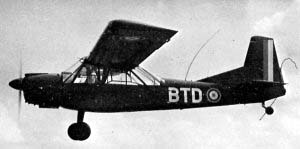Nord 3400
| Nord 3400 Norbarbe | |
|---|---|
 | |
| Role | Two-seat army liaison |
| National origin | France |
| Manufacturer | Nord Aviation |
| First flight | 1958 |
| Introduction | 1959 |
| Primary user | French Army Light Aviation |
| Produced | 1959-1961 |
| Number built | 152 |
The Nord 3400 Norbarbe was a French two-seat observation and casualty-evacuation aircraft built by Nord Aviation for the French Army Light Aviation.[1]
Design and development[edit]
The Nord 3400 was designed to meet a French Army requirement for a two-seat observation aircraft, with a secondary casualty-evacuation role. The 3400 was a braced high-wing monoplane with a fixed tailwheel landing gear and an enclosed cabin with tandem seating for a pilot and observer. The prototype F-MBTD first flew on 20 January 1958, powered by a 179 kW (240 hp) Potez 4D-30 engine. A second prototype with an increased wing area followed, being powered by a 194 kW (260 hp) Potez 4D-34 engine. A production batch of 150 was ordered by the French Army in the same configuration as the second prototype.
Variants[edit]
- Nord 3400-01
- First prototype, powered by a 179 kW (240 hp) Potez 4D-30 engine, with, 12.7 m (42 ft) span/19.5 m2 (210 sq ft) area, wings.[2]
- Nord 3400
- Production aircraft (and 2nd prototype), with a more powerful 194 kW (260 hp) Potez 4D-34 engine and increased span/area wings.[3]
Operators[edit]

Specifications (Nord 3400)[edit]
Data from Jane's All the World's Aircraft 1962-63[3]
General characteristics
- Crew: 2
- Length: 8.42 m (27 ft 7 in)
- Wingspan: 13.11 m (43 ft 0 in)
- Height: 3.1 m (10 ft 2 in)
- Wing area: 20.82 m2 (224.1 sq ft)
- Aspect ratio: 8.2
- Airfoil: NACA 23015[4]
- Empty weight: 920 kg (2,028 lb) equipped
- Max takeoff weight: 1,350 kg (2,976 lb)
- Fuel capacity: 220 L (58.1 US gal; 48.4 imp gal) in two self-sealing rubber tanks (160 kg (353 lb))
- Powerplant: 1 × Potez 4D-30 4-cylinder air-cooled inverted in-line piston engine, 180 kW (240 hp)
- Propellers: 2-bladed Ratier Type 24-56 adjustable-pitch propeller, 2.25 m (7 ft 5 in) diameter adjustable-pitch propeller
Performance
- Maximum speed: 235 km/h (146 mph, 127 kn)
- Cruise speed: 200 km/h (120 mph, 110 kn)
- Stall speed: 70 km/h (43 mph, 38 kn) <
- Range: 1,000 km (620 mi, 540 nmi)
- Rate of climb: 7 m/s (1,400 ft/min)
- Wing loading: 65 kg/m2 (13 lb/sq ft)
- Power/mass: 0.192 kW/kg (0.117 hp/lb)
- Take-off run: <100 m (328 ft)
- Landing run: <100 m (328 ft)
See also[edit]
Related lists
References[edit]
- ^ Flying Magazine: 50. August 1961.
{{cite journal}}: Missing or empty|title=(help) - ^ Bridgman, Leonard, ed. (1957). Jane's All the World's Aircraft 1958-59. London: Jane's All the World's Aircraft Publishing Co. Ltd. p. 161.
- ^ a b Taylor, John W.R., ed. (1962). Jane's All the World's Aircraft 1962-63. London: Sampson Low, Marston & Co. p. 49.
- ^ Lednicer, David. "The Incomplete Guide to Airfoil Usage". m-selig.ae.illinois.edu. Retrieved 16 April 2019.
Further reading[edit]
- Taylor, Michael J. H. (1989). Jane's Encyclopedia of Aviation. London: Studio Editions.
- The Illustrated Encyclopedia of Aircraft (Part Work 1982-1985). Orbis Publishing.


 French
French Deutsch
Deutsch